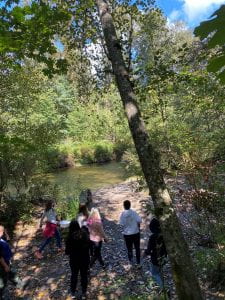Intr oduction – Recently My class went on a field study to test the water quality of the Coquitlam river and the Oxbow pond as a part of our spheres unit. Testing the water quality of the river and the pond ties into our study of the hydrosphere, which is one of the four spheres. Our objective was to find out how healthy the river and the pond are. Water quality is tested on the amount of dissolved oxygen, the amount of nitrates, the water temperature, the total amount of dissolved solids, the pH balance of the water, the amount of phosphates in the water, and the water turbidity. Another way we tested the water quality was by recording the invertebrates we found in bodies of water.
oduction – Recently My class went on a field study to test the water quality of the Coquitlam river and the Oxbow pond as a part of our spheres unit. Testing the water quality of the river and the pond ties into our study of the hydrosphere, which is one of the four spheres. Our objective was to find out how healthy the river and the pond are. Water quality is tested on the amount of dissolved oxygen, the amount of nitrates, the water temperature, the total amount of dissolved solids, the pH balance of the water, the amount of phosphates in the water, and the water turbidity. Another way we tested the water quality was by recording the invertebrates we found in bodies of water.
The Coquitlam River – Our results from testing the river showed that the water quality is good and a healthy environment for aquatic animals. We found out that the amount of dissolved oxygen was optimal as well as the number of nitrates found in the water. The amount dissolved oxygen in water its he most important factor for determining the overall water quality. We found a  mayflies and mayfly larvae, we also found stoneflies and damselflies. The invertebrates that we found also Indicated that the water quality was good, since they are not tolerant to polluted water. The poorest scoring factor for the Coquitlam River was its pH balance.
mayflies and mayfly larvae, we also found stoneflies and damselflies. The invertebrates that we found also Indicated that the water quality was good, since they are not tolerant to polluted water. The poorest scoring factor for the Coquitlam River was its pH balance.
The Oxbow Pond – The pond had a good overall water quality index, however it scored significantly less than the river. The levels of dissolved oxygen were great so were the levels of nitrates. The amount of phosphates found in the water would be considered low for good water quality. On the off hand the pH level scored higher than what I expected it to be. The pH balance is the second most important factor in water quality behind dissolved oxygen. The invertebrates that we found in the pond indicated that the water quality was average. We found two water pennies, two dragonfly larvae, three rifle beetles, and a lot of small fish. Which are all part of appendix 2, which is the invertebrates that a re able to tolerate more polluted water.
re able to tolerate more polluted water.
Reflection – Through this activity I learned about the different types of invertebrates and the effect of the water quality on the aquatic food chain. I enjoyed this chance to do hands on learning and going out for a field study. I think the experience helped me understand the material better and understand the importance of what we were learning about. I found it cool to be able to do a “mock” version of what scientists actually do for a living, and being able to be engaged with the environment around us.
0 comments on “Water Quality Testing” Add yours →